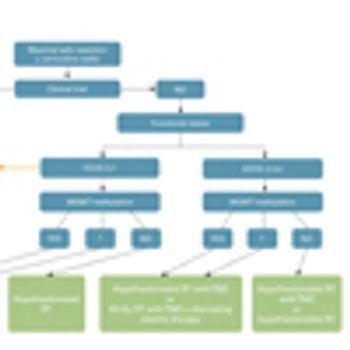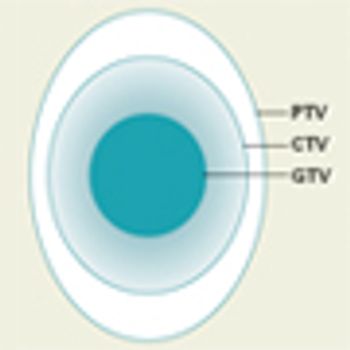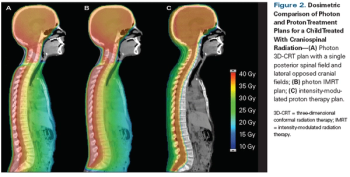
A personalized peptide vaccination shows clinical benefit for human leukocyte antigen-A24-positive glioblastoma multiforme patients refractory to temozolomide-based therapy.

Your AI-Trained Oncology Knowledge Connection!


A personalized peptide vaccination shows clinical benefit for human leukocyte antigen-A24-positive glioblastoma multiforme patients refractory to temozolomide-based therapy.

The US Food and Drug Administration has approved the optical imaging agent aminolevulinic acid hydrochloride to enhance visualization of malignant tissue during surgery for gliomas.

An intraoperative, multimodal optical cancer detection system can detect brain cancer with high degrees of accuracy, sensitivity, and specificity in real time during surgery, according to a new study.

This review discusses best practices for the treatment of glioblastoma in patients older than 65 years, and highlights management concerns in caring for this particular patient population.

Administration of autologous HER2-specific CAR-modified virus specific T Cells was safe and had clinical benefit for some patients with progressive glioblastoma, a disease with limited effective therapeutic options.

This video examines current research on the use of vaccines in low-grade glioma for the prevention of high-grade disease.

Cytomegalovirus targeted vaccination plus high-dose chemotherapy with temozolomide can lead to long-term progression-free and overall survival in patients with newly diagnosed glioblastoma.

This video examines how a specific combination of KIR/KIR-ligand genotypes in high-risk neuroblastoma patients may be predictive of outcomes when adding dinutuximab to isotretinoin.

Elderly patients with glioblastoma had longer survival when temozolomide was added to short-course radiotherapy compared with undergoing short-course radiotherapy alone.

Minimizing late treatment toxicities in these patients remains an important priority due to both the young age of the patients and the high cure rate that can be achieved.

In this article we discuss the specifics of refining current strategies for radiation delivery, as well as new and up-and-coming heavy particle techniques and radiotherapeutics.

The addition of an autologous tumor derived–heat shock protein vaccination to standard therapy may improve outcomes for patients with glioblastoma.

A study showed that testing pediatric brain tumors for genetic abnormalities is feasible and could play a role in guiding patients’ treatment.

Many childhood brain tumors harbor potentially targetable gene mutations, according to a prospective single-institution study of more than 200 tumor samples, researchers reported in the journal Neuro-Oncology.

Brain metastases from primary breast cancer tumors often acquire clinically actionable genetic alterations, according to a small study. About one fifth of ERBB2/HER2-negative cases switched to HER2-positivity in the brain metastases.

Researchers are reporting in the journal Cancer Research that they have identified a biomarker enzyme associated with aggressive glioma brain tumors. In addition, they have demonstrated potent efficacy in a mouse model of glioma for a small molecule inhibitor they recently developed.

A 22-year-old college student with primary amenorrhea due to Müllerian agenesis presented with a headache, dysarthria, nausea, vomiting, and left upper extremity weakness. MRI of the brain showed numerous intracranial lesions.

Epigenetic lesions, and not just genetic mutations, can cause brain cancer, and one important implication of that observation is that precision-medicine genetic and genomic tools will miss epigenetic lesions that may drive tumor growth or drug resistance.

An updated prognostic tool incorporating gene alteration data could help guide clinical management of patients with non–small-cell lung cancer.

IDH1-mutant gliomas can affect adjacent, nonmalignant cells in ways that trigger seizures, according to research reported at the 21st Annual Scientific Meeting of the Society for Neuro-Oncology.

Computer analysis of subvisual data extracted from routine clinical MRI exams outperforms human experts at differentiating brain tumor recurrence from radiation necrosis.

In this interview we discuss findings from M12-356, an open-label, phase I, escalation cohort study of the investigational anti-EGFR antibody-drug conjugate ABT-414 for patients with EGFR-amplified recurrent glioblastoma.

Four years in the making, the new 2016 World Health Organization Classification of Tumors of the Central Nervous System includes new genetically identified entities and variants, allowing more diagnostic precision, and a new “layered” approach to diagnosis.

Caring for patients with brain tumors can have marked effects on the well-being of oncology clinicians, frequently leading to burnout, and authors of an ongoing survey study aim to get a clearer picture of those impacts.

The anti-inflammatory ibudilast shows early preclinical promise against glioblastoma cell lines when combined with temozolomide, according to new research.